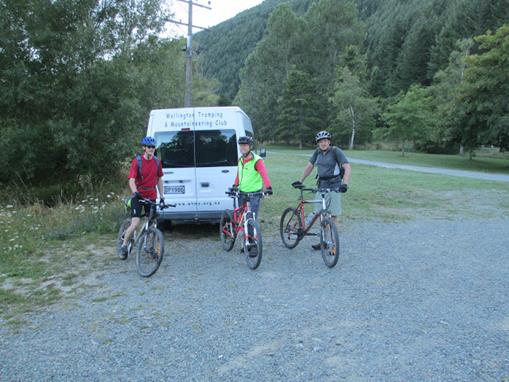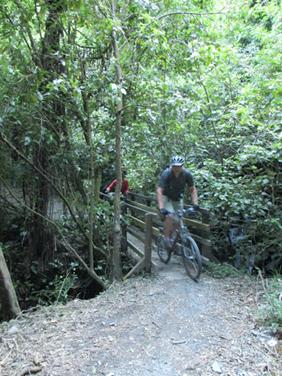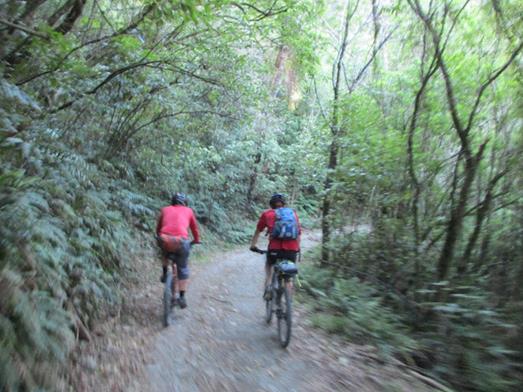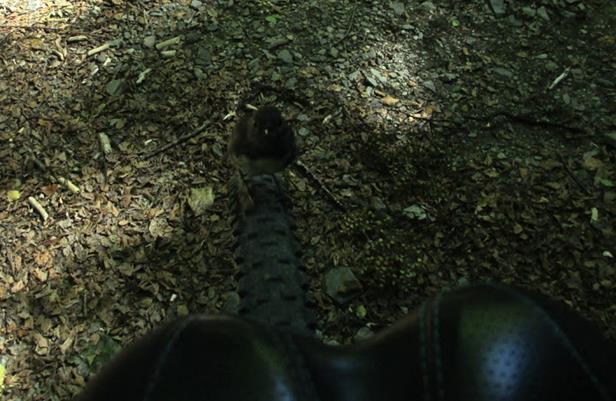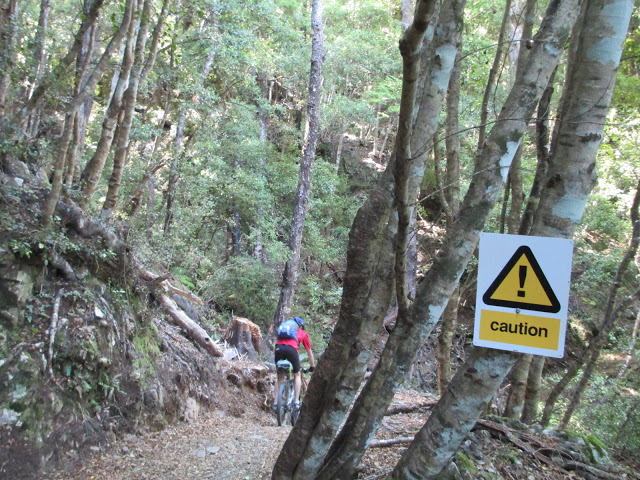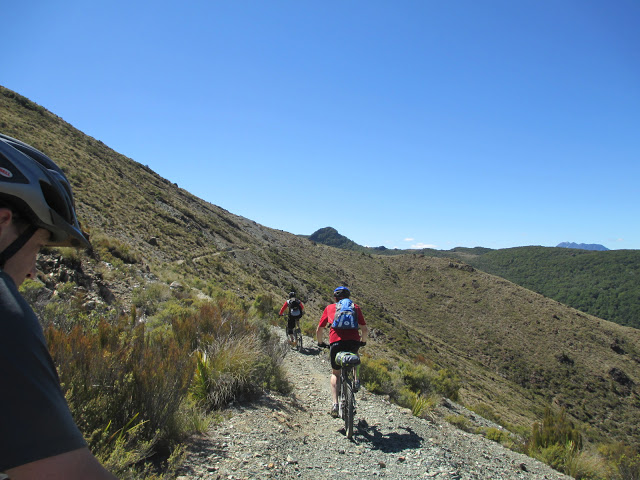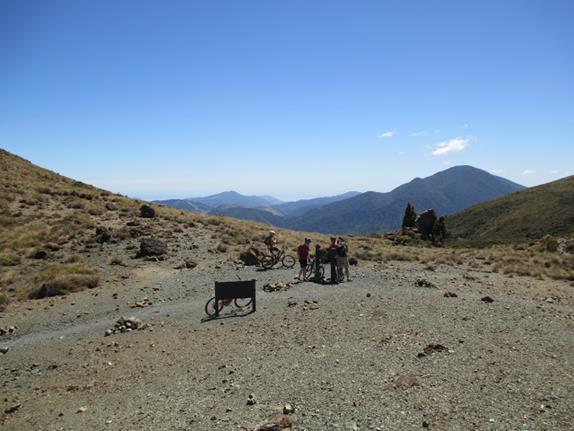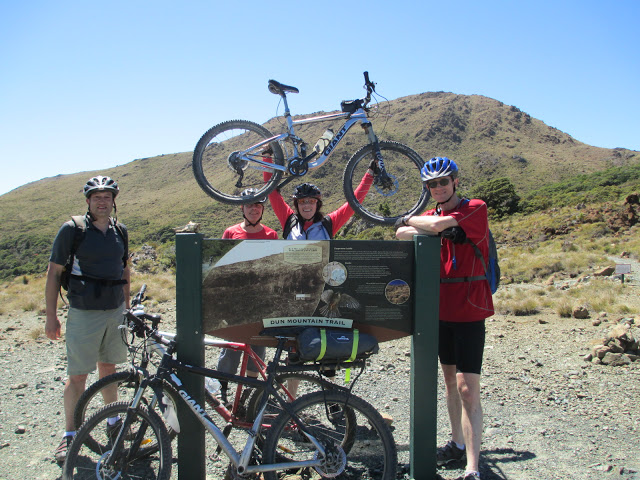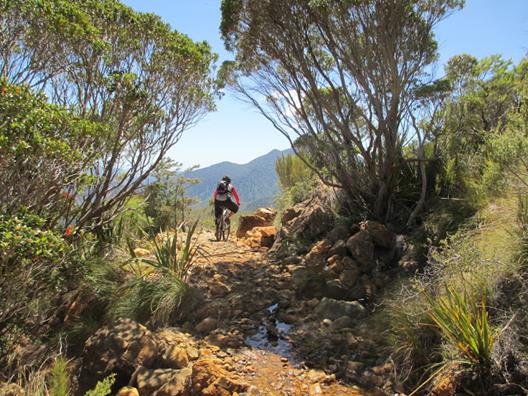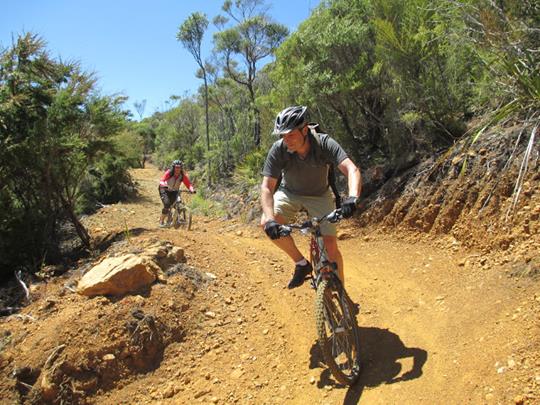On Monday morning we thank Hans and Mika for their kind hospitality and throw bikes in and on the van. We are joined for the day by Julie and Thomas who, as seasoned bikers, will hopefully not mind travelling at our pace.
To avoid having to climb Tantragee Saddle at the end of the ride we park in Maitai Valley and start from there. After the short climb to the saddle, the Dun Mt track sidles from Nelson gradually up to 870m along an old railway built to service chromite mines on Wooded Peak. It is a very well-constructed track; easily graded and ride-able throughout.
Signs are placed along the route with history of the railway (and related mining) and information on local flora and fauna. There are a few historic sites on the way including a shelter (Third House at 670m). The track is mostly through beech forest but there are a few spots with spectacular views across the Nelson plains.
After Third House the track gradually gets a little rougher but is still easily ride-able. We are distracted en route by a bush robin that has no fear. Hopping on bikes and feet and testing valve caps for potential edibility. It quite diverts us from our mission for a while.
It is cool in the beech forest but just before Windy Point at around 830m we suddenly break out onto the tops. This is not the normal tree line but the edge of a rock type that is basically toxic. From a distance, the delineation between rich forest and the harsh ultramafic landscape around Mt Dun looks like a farm fence line. Close up, we can see the contrast in vegetation. The plants that are growing are stunted and look like they’re having a tough time getting by. The rock colours change from predominantly grey to browns, greens, black and, as we travel, more and more dun (due to oxidisation of the high iron content).
The area gives its name to dunite, an ultramafic rock composed largely of olivine (over 90%) and other minerals, in this case chromite. Dunite and related rocks are considered the major constituents of the Earth’s mantle to a depth of up to 400 kilometres, and rarely found continentally. Mt Dun has a sister massif in Red Mountain on the southern West Coast 480km away displaced by movement of the alpine fault (info from Wiki and Te Ara).
With the trees behind us, the horizon to the west is broad; traversing from the Abel Tasman in the north, through Mr Arthur, Mt Owen and south. The track sidles to our highest point; Coppermine Saddle at 870m and for the second time this weekend a view into the Maitai catchment.
The downhill is MTBing nirvana. The fast flowing track is narrow and cut into the yellow brown soil with tricky sides and a thousand little surprises for the unwary. It can be taken at speed (keep your concentration or look out) but is equally passable at a more sedate pace for less foolhardy riders.
We lose height rapidly through the hairpins and chicanes, at 320m passing from the Dun Mt vegetation to more usual bush and the cooler air around Maitai Stream South. Our first casualty is experienced at this point with a snake bite puncture to Mike’s bike. It is quickly fixed and we follow the track as it flattens and smoothes giving fast riding down the valley to Maitai reservoir.
Our second casualty occurs minutes later as a bee throws itself down Thomas’ top. It gives him a bit of a souvenir but he has the presence of mind to stay on the track.
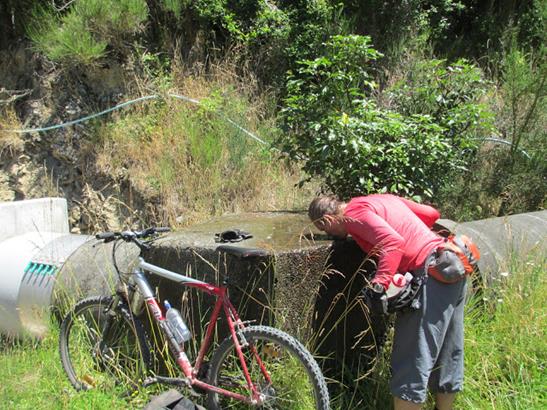
We re-join yesterday’s route at the bottom of the caretaker’s hill to be back at the van and gone by 2.30; a little later than intended. The tubers are waiting at their road end up the Pelorus valley and in the end we arrive at the ferry 5 minutes after ‘final’ check-in but in plenty of time for the hour long wait in the queue.
Summary comments
Both rides are easily accessed from Nelson providing a lot of accommodation options. We took it easy on all days never spending much more than 6 hours. This could readily be trimmed if you were of a mind and of medium or better fitness.
Dun Mountain This is a great ride and the pick of the weekend. It has an easy grade up giving options for family riding, spectacular views and interesting history and geology. From Coppermine Saddle you can return the way you came or enjoy the exciting descent on a well-formed track to the Maitai. There’s a fair part of the trip between streams and we weren’t keen to drink from small streams on Mt Dun, it’s probably best to carry enough water for the whole trip.
Maungatapu is a do-able ride but there’s quite a bit of pushing unless you are a strong rider. The down hills are exciting on both sides; Pelorus side because you can go very fast and Nelson side because they are steep and a little more technical. The views are pretty good. On balance we would recommend going from Pelorus as you can ride more of the uphill side and can ride down the sections you would be pushing up on the Nelson side. There are water sources on both sides but some gaps between the last stream on the way up and the first on the way down (including the amazing disappearing Maitai River North Branch). Bike bypass around road works in Maitai valley are catered for and the issue will probably pass before too long. Camping at Pelorus is a highly recommended variation.
All in all a successful first club trip leading experience. Compared to tramping there is a lot more gear and organising required for a MTB trip, particularly to accommodate repairs to bikes between rides, and even more so because our plan involved leaving a gear stash. However, the club arranged all the ferry bookings at good rates and provided the van, ready to go, which made things a lot easier.
Having good natured advice and assistance from a longer serving club member (this time in the form of Mike) is the sort of support that any first time trip leader would appreciate.

